|
Visionaries: Protecting the future of
the Gulf of Maine
Making a difference
By Susan Llewelyn Leach
[printer friendly page]
Each year, the Gulf of Maine
Council gives out Visionary and Longard Awards recognizing innovation,
creativity and commitment to protecting the marine environment
of the Gulf of Maine. The Visionary Awards are presented to two
individuals, businesses or organizations within each state and
province bordering the Gulf of Maine.
One Longard Award is presented
to an unpaid individual from one of the five states and provinces
who is dedicated to environmental protection and sustainability
of natural resources within the marine, near shore and watershed
environments of the Gulf of Maine (see story on Roger Berle,
Pages 1,8). The award is named in memory of Art Longard, a founding
member of the Gulf of Maine Council.
Massachusetts
Susan Jones Moses
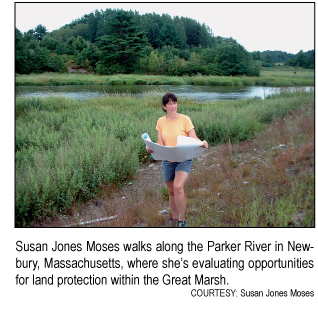 Growing up in the shadow of the
six-million-acre (2.4-million-hectare) Adirondack Park in New
York State, Susan Jones Moses was never far from open spaces
and natural water — the type of environment she now works
so hard to protect in Essex County. Growing up in the shadow of the
six-million-acre (2.4-million-hectare) Adirondack Park in New
York State, Susan Jones Moses was never far from open spaces
and natural water — the type of environment she now works
so hard to protect in Essex County.
When she first moved to the North
Shore of Massachusetts in 1992, she said she was struck by the
pace of development. In her own town of Rowley, which sits on
the edge of Great Marsh, agricultural land was rapidly disappearing
to new housing. Jones Moses went to work. Combining her expertise
as a planning consultant with her flair for distilling complex
issues into terms people could understand, she built local support
for town overrides and laws that now protect more than 400 acres
(162 hectares) of the marsh’s watershed.
Her successes in Rowley as a
volunteer crisscrossed with her planning career and led to a
contract with the Essex County Forum. The county’s 34 communities
now look to her for zoning and land protection advice. While
she sees her job as part education, part technical assistance,
often the biggest challenge is getting property owners to recognize
the connection between the land and marine environment, she said.
“Whatever people do on their land doesn’t just stay
on their land,” she explained. “Their actions affect
the sea a mile (1.6 kilometers) away.”
Her educational push also comes
in the form of workshops on smart growth issues for local planning
and zoning boards. She argues for open space protection to be
an integral part of affordable-housing design. At the most fundamental
level, she challenges people to think outside their own interests.
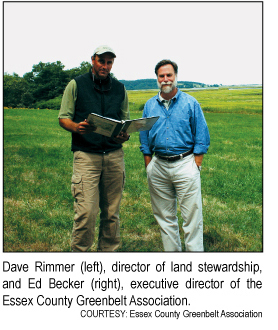 Essex
County Greenbelt Association Essex
County Greenbelt Association
Ed Becker reckons there are two decades left to make a difference.
The executive director of the Essex County Greenbelt Association
is referring to the nonprofit’s conservation efforts. Over
the years the land trust, based on the North Shore of Massachusetts,
has steadily acquired parcels of land that have ecological, scenic
or agricultural value. But as prices soar and development encroaches,
the opportunity to protect is diminishing.
“We know that 25 percent
of the land base left is available for development,” Becker
said. But not all of that is worth conserving. As the window
closes, Greenbelt is becoming more strategic and proactive in
reaching out to landowners,Becker said.
In 46 years, the association
has protected more than 12,000 acres (4,856 hectares) of land
and transformed 4,500 acres (1,821 hectares) of that into a reservation
system open to the public. Some of those parcels skirt Great
Marsh and offer unique opportunities to bird watch, hike and
canoe. Walks, talks and a guidebook are all part of the organization’s
educational output along with information on the natural history
of all the reservations.
As its name suggests, Greenbelt
is keen to create natural corridors along rivers, streams and
coastlines both for the view and the environmental benefit. Past
successes and a reputation for getting things done have aided
that quest, Becker said. The organization is often approached
by owners wishing to gift their property or create a conservation
easement.
Increasingly, he said, Greenbelt
is using that real estate experience to assist cities and towns
in Essex County to protect more open space and compound the conservation
effort.
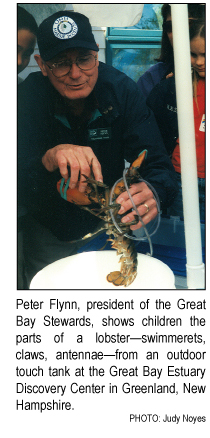 New
Hampshire New
Hampshire
Great Bay Stewards
Each day salt water comes rushing up the Piscataqua River in
a 10-mile (16-kilometer) race to meet fresh water in New Hampshire’s
Great Bay. That mingling of sea and river in the country’s
most recessed estuary has created a unique ecosystem, one that
the Great Bay Stewards are working to protect.
The Great Bay National Estuarine
Research Reserve was established in 1989, and five years later
a Discovery Center was built at Sandy Point on the bay. The Stewards
came along in 1995 to support the reserve and the center, monitor
the watershed and organize fund-raising and educational events
for children and adults.
Each year, the Stewards offer
two University of New Hampshire students $1,000 each to do a
research project on the bay. One project last year measured the
nitrogen levels around the bay and thus the pollution, said Peter
Flynn, the president of the Stewards.
As their name suggests, the Stewards
regularly check that no building or dumping is going on in lands
with conservation easements along the bay’s shores. But
the biggest challenge, Flynn confided, is providing funds and
assistance to volunteer efforts. With the help of its 200 members,
the nonprofit organizes many fund-raising events, such as 5K
races and art shows. And although each event doesn’t bring
in large sums, he said, the public learns of the conservation
efforts for the bay. And that educational outreach is just as
critical. “It’s amazing to me how many people who have
lived here for years don’t know what the Great Bay estuary
is all about,” Flynn said. “Many still think it’s
a lake.”
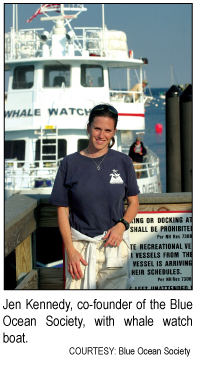 Jen
Kennedy and Dianna Schulte Jen
Kennedy and Dianna Schulte
If you want to capture children’s attention, introduce them
to a 60-foot (18-meter) inflatable fin whale. That’s the
approach of Jen Kennedy and Dianna Schulte, who use the home-made
mammal in school presentations on the marine environment.
The two whale-watch naturalists
and cofounders of The Blue Ocean Society for Marine Conservation
work hard to engage children and the public. To that end, the
Portsmouth, New Hampshire, nonprofit coordinates with four local
whale watch companies and offers presentations to waiting passengers.
Since people learn in different
ways, Kennedy said, the naturalists try to address all the senses
— through whale sounds, reading materials, touch tanks and
talks. The touch tanks, an idea Kennedy developed with the help
of interns, sits dockside full of small sea creatures people
can meet up close. But perhaps not too close since they include
crabs, sea urchins and sea stars.
Education is only half the story.
Blue Ocean collects data on marine life from the whale boats
and tracks floating debris. Whale fins are photographed and a
detailed record of each mammal’s behavior noted and catalogued.
All this data is then shared with other whale research organizations
in Maine and Massachusetts and made available to the public.
It even becomes the basis for science projects in schools.
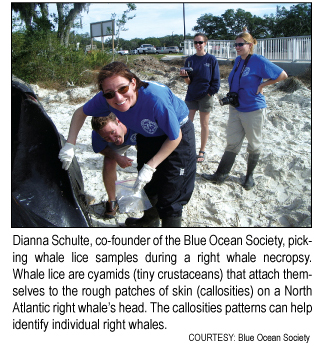 Blue
Ocean’s research on endangered species also helps conservation
efforts and is used to identify areas that need protection. Regular
beach cleanups and an Adopt-a-Beach program begun in 2004 have
become successes, with 25 “adoptions” so far. Blue
Ocean’s research on endangered species also helps conservation
efforts and is used to identify areas that need protection. Regular
beach cleanups and an Adopt-a-Beach program begun in 2004 have
become successes, with 25 “adoptions” so far.
Maine
Jane Disney
Jane Disney claims no credit. She said her students took her
places she didn’t have the courage to go. The Mount Desert
Island Water Quality Coalition (MDIWQC) grew out of their initiative,
the former biology teacher said. And in the space of a few years,
since its inception in 2000, the coalition has lived up to its
name. By drawing together children, college students, island
residents, businesses and fishermen into its projects, it has
built community awareness of the local watershed and fundamentally
changed people’s behavior.
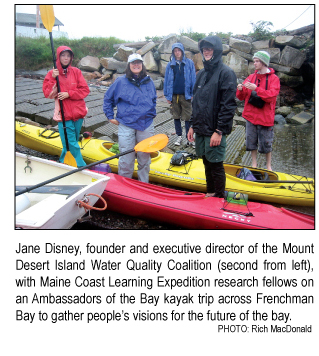 It all started at Seal Harbor Beach. There, the
students monitored water quality to identify pollution issues
that threatened public health. From that the coalition gathered
momentum and now includes regular surveys of clam flats and the
shoreline; plankton and beach monitoring; research and education
at its bio lab and the Community Environmental Health Laboratory,
which runs in partnership with the MDI Biological Laboratory
in Salisbury Cove (Bar Harbor); and student internships and community
outreach programs. It all started at Seal Harbor Beach. There, the
students monitored water quality to identify pollution issues
that threatened public health. From that the coalition gathered
momentum and now includes regular surveys of clam flats and the
shoreline; plankton and beach monitoring; research and education
at its bio lab and the Community Environmental Health Laboratory,
which runs in partnership with the MDI Biological Laboratory
in Salisbury Cove (Bar Harbor); and student internships and community
outreach programs.
Many projects have become an
integral part of the region’s school science curriculum.
For third graders, that means trooping out to storm drains, collecting
data about the trash around them and stenciling a large stylized
fish and warning sign. This alerts the public that the drains
dump directly into the bay.
The children get “pretty
worked up about runoff,” said Disney, now executive director
of MDIWQC. It’s an example of how youthful energy can galvanize
town council members into acting on their responsibility to the
next generation, she said. “Kids here are leading the call
to action.”
Susan Shaw
The issue seems surprisingly simple. People understand when humans
are at risk from toxic chemicals, but they don’t recognize
when marine mammals are, said Susan Shaw. And nor do they see
the significance of the link between the two. Her institute’s
groundbreaking research into harbor seals is exposing that connection
and changing public policy along the way.
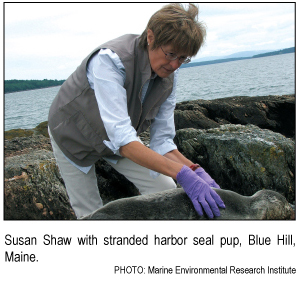 For
several years, the Seals as Sentinels project, run out of the
Marine Environmental Research Institute Shaw founded in Blue
Hill, Maine, has been identifying alarming levels of pollutants
in the Gulf of Maine’s harbor seal populations. Along with
PCBs, Shaw discovered rising concentrations of flame retardants
in the seals. That was a first. Not only did the flame retardant
data attract international attention, it influenced the state’s
decision to ban the most widely used commercial form, DecaBDE.
For this work, the state of Maine honored her with a special
Citation of Recognition. For
several years, the Seals as Sentinels project, run out of the
Marine Environmental Research Institute Shaw founded in Blue
Hill, Maine, has been identifying alarming levels of pollutants
in the Gulf of Maine’s harbor seal populations. Along with
PCBs, Shaw discovered rising concentrations of flame retardants
in the seals. That was a first. Not only did the flame retardant
data attract international attention, it influenced the state’s
decision to ban the most widely used commercial form, DecaBDE.
For this work, the state of Maine honored her with a special
Citation of Recognition.
From small beginnings 17 years
ago, Shaw’s research institute — with marine labs,
a field station and an aquarium that mimics the Gulf of Maine’s
ecosystem — has been gaining international recognition for
its scientific leadership. And Shaw is the gently-spoken force
behind those breakthroughs.
Her path to this point has been
marked by a desire to understand the world, she said, to find
new ways of seeing, whether through photography, public health
or marine research. She shares that understanding liberally.
In the international arena, she gives papers at conferences,
this year in Tokyo and Cape Town. Locally, her institute offers
water quality monitoring, educational programs and an environmental
lecture series.
Shaw said she feels some urgency.
The United States was late to the table in recognizing the ocean
crisis, she said. “I hope it’s not too late.”
New Brunswick
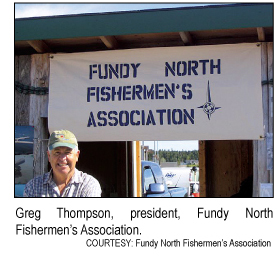 Greg Thompson Greg Thompson
Fishermen are an independent lot. And they pride themselves on
it, said Greg Thompson, a lifelong fisherman of New Brunswick’s
waters. But over recent years aquaculture, liquefied natural
gas terminal tugboats and other claims to the open ocean have
encroached on that celebrated independence. The shift has not
been easy.
As a founding member of the Fundy
North Fishermen’s Association in the late 1970s, Thompson
has had fishermen’s interests in his sights for years. Of
the 150 or so fishermen in Fundy North almost half are members
of the voluntary organization — an achievement in itself.
But what particularly encourages him is their growing awareness.
“Our fishermen are a little more open to looking at the
good of the fishery as a whole — open to the concept that
it is a common property or resource,” he said. “It’s
a form of maturity.”
That accomplishment didn’t
come without decades of effort and initiative. Years ago, when
the government imposed quotas to halt declining ground fish stocks,
battles ensued. Each fisherman wanted at least what he or she
had before, Thompson said, if not more. “We fought each
other over each fish.” Out of that head-to-head grew community-based
fisheries management, a system Thompson helped develop. It allocates
quotas to fishing communities rather than individual fishermen.
The main benefit: Communities manage to keep their small fishing
enterprises. That’s key, he said, because when a community
loses its fishery, it’s like losing a school or a church
— a valuable dimension disappears.
Building consensus is a theme
for Thompson. It’s the only way ahead, as he sees it. So
as the demands on the Bay of Fundy grow — from fisheries
and aquaculture to tourism and industry — he’s working
hard alongside others to integrate them in a marine planning
process for southern New Brunswick.
Friends of Musquash
Estuaries offer a rare meeting of salt water and fresh. In that
tidal mix, they support a wide range of wildlife and marine species.
Musquash Estuary on the Bay of Fundy is a rarer spot still —
an estuary whose ecology and salt marshes have remained largely
intact over the decades. A 1990 study identified it as the only
estuary in the region not subject to major development: no seaport,
aquaculture, industry, dredging or residential buildup.
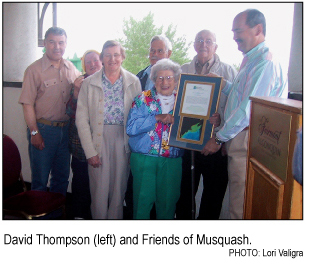 That
confluence of conditions led the Conservation Council of New
Brunswick and the Fundy North Fishermen’s Association to
propose making the estuary a Marine Protected Area (MPA) in 1998.
In March 2007 it became an official MPA. That
confluence of conditions led the Conservation Council of New
Brunswick and the Fundy North Fishermen’s Association to
propose making the estuary a Marine Protected Area (MPA) in 1998.
In March 2007 it became an official MPA.
One of the biggest players in
nudging the project forward during those years was the Friends
of Musquash, a group of local residents, stakeholders and interest
groups. Formed in the late 1990s, the Friends facilitated forums
and coordinated with government officials over future management
of the MPA.
David Thompson, the president
of Friends, attributed much of the ultimate success of the venture
to the perseverance of local residents, people who have lived
on the edges of the estuary for generations and wholeheartedly
supported the proposal.
Now that the MPA is in place,
the Friends will become “the eyes and ears surrounding the
estuary,” Thompson said. Members will do field work the
government is too understaffed to carry out and offer on-the-ground
guidance and advice to Fisheries and Oceans Canada, which oversees
the eight-mile (13-kilometer) estuary.
Nova Scotia
Clifford Drysdale
Turtles are known to be slow. But in southwest Nova Scotia, the
Blanding’s variety is also a distance walker. That was one
finding of the Mersey Tobeatic Research Institute (MTRI) project
to advance habitat connectivity for species at risk.
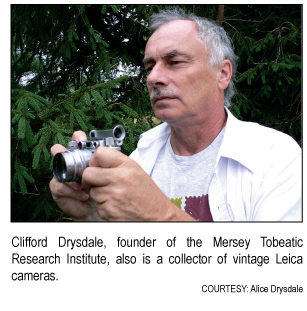 The
Blanding’s turtle recovery team researchers worked in cooperation
with staff, trustees and representatives from various levels
of government. The results influenced a local logging company
to set aside a patch of land to accommodate the turtles’
wanderings and protect nesting sites. The
Blanding’s turtle recovery team researchers worked in cooperation
with staff, trustees and representatives from various levels
of government. The results influenced a local logging company
to set aside a patch of land to accommodate the turtles’
wanderings and protect nesting sites.
It’s one small example of
MTRI’s collaborative approach to research, said Clifford
Drysdale, the institute’s chairman and chief executive officer.
Forestry is the primary industry in the region, yet there’s
an open cooperation between landowners, scientists and loggers.
That weaving of different interests
is part of MTRI’s role, which Drysdale described as a combination
of catalyst and partner. Established in 2004 by a group of scientists
with the support of industry, educators and local residents,
the institute has quickly become a hub of new research, data
exchange and education programs, all in the service of promoting
sustainable use of resources and biodiversity conservation.
With 30 years’ experience
as an ecosystem science manager at Kejimkujik National Park and
National Historic Site in Nova Scotia, Drysdale, now retired
from Parks Canada, is in his element. Still, the public’s
interest and enthusiasm for the institute’s volunteering
and monitoring programs have been especially encouraging. It
seems to have caught the imagination of the local people, he
said modestly. Children meet and talk to the scientists as part
of school programs. And research is openly shared with the public
as a way to promote conservation.
Coastal Communities Network
The heart of the Coastal Communities Network, said Executive
Director Ishbel Munro, is its ability to provide a meeting ground
for a broad range of voices and views. Fishermen rub shoulders
with church people, First Nation members share ideas with Acadians,
and environmentalists chat with youth groups.
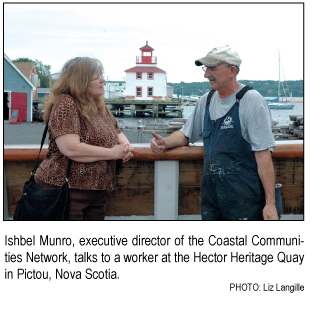 It’s
a network with a big goal: to sustain the social and economic
well-being of the small communities that skirt the province’s
coast and dot its rural inland. It’s
a network with a big goal: to sustain the social and economic
well-being of the small communities that skirt the province’s
coast and dot its rural inland.
It all started with the cod crisis.
In the early 1990s, the ground fishing industry collapsed and
with it much of the economic fiber of the region. Munro worked
on a committee that organized a series of seminars to discuss
the crisis, drawing together all threads of the community. These
were people who had rarely stood in the same room, let alone
discussed fisheries. It was time to set differences aside, Munro
said. It became the unofficial beginning of the Coastal Communities
Network (CCN).
From there, CCN has grown into
an information clearinghouse and generator of creative solutions
for local communities. It holds rural policy forums and workshops,
and gathers research that communities can draw upon to address
their own needs. It also publishes a magazine and maintains a
resource-rich Web site. In isolated communities particularly,
Munro said, the monthly meetings can be a lifeline and offer
much-needed moral support.
One of CCN’s biggest successes
has been its work on wharfs. “They’re how [you] get
to work if you’re a fishing person,” she said, describing
them as the linchpin of coastal communities. With 255 wharves
in Nova Scotia, the maintenance bill has been overwhelming. CCN
jumped in and helped secure federal funding. Then the network
did what it excels at: it held workshops to educate people about
the role wharves play in the economy and community.
Susan Llewelyn Leach is a
free-lance writer based in Cambridge, Massachusetts.
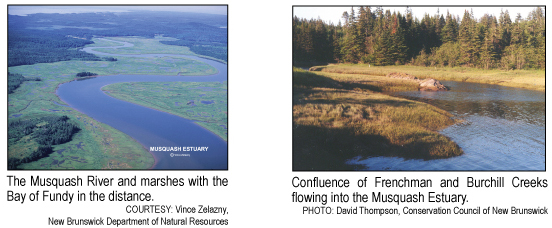
|
![]()
